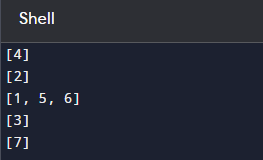Vertical order traversal of Binary Tree using MapWhen a binary tree is traversed using the vertical order traversal algorithm, nodes that are vertically next to the root are gathered together. The nodes are processed from top to bottom and from left to right within the same vertical distance. We can use a map or dictionary to link each vertical distance with the nodes at that distance in order to accomplish a vertical order traverse. Starting at the root, we move up the tree while keeping the vertical separation between each node constant. The nodes are then kept in the Map's corresponding vertical distance group. Here is a step-by-step algorithm for completing a map's vertical order traversal:
ImplementationIt takes several stages to implement vertical order traversal of a binary tree using a map. Here is how to carry out this traversal step by step: Create a class to represent the nodes of the binary tree by defining the tree's node structure. A value, a left child, and a right child should be present in every node. Create a Map from Scratch and Store Nodes by Vertical Distance: Create a map to hold the nodes at each vertical distance, such as a dictionary in Python. The vertical distance will serve as the Map's key, while a list of nodes will serve as its value. Perform a breadth-first traversal of the binary tree, noting the vertical distance of each node from the root as you go (for instance, by using a queue). Begin with the Update the Map: Add the node's value from the list that corresponds to its vertical distance to the Map for each node that is met throughout the traverse. Extract the Vertical Order: The Map will contain nodes arranged in ascending order after traversing the entire tree. Using the vertical distances as a guide, extract the nodes in the proper order. Printing or processing the nodes in the proper vertical order may require iterating across the Map and gaining access to the nodes at each vertical distance. from collections import defaultdict, deque Code 
In this illustration, the binary tree is traversed in a vertical sequence, and each group of nodes that are adjacent to one another vertically is printed on a distinct line. The overall viewAn efficient method for visiting nodes in a binary tree according to their vertical distances from the root is to traverse the tree vertically using a map. This traversal enables grouping nodes according to their respective vertical lines in the tree by assigning each node a vertical distance and using a map data structure. The following are some essential ideas and findings with reference to traversing a vertical order on a map: Node organization: Nodes are arranged during traversal according to how far away from the root they are vertically. It is simple to extract nodes for vertical traversal since nodes that are separated vertically by the same amount are grouped. Data structure for maps Nodes are frequently organized into groups according to their vertical distances using a map (such as a dictionary). A list of the nodes at each key's associated value reflects a certain vertical distance on the Map. Performance and Efficiency: It is simpler to extract nodes in the right sequence for vertical traversal when using a map to arrange nodes efficiently. Vertical order traversal using a map typically has an O(n log n) time complexity, where n is the number of nodes. Use cases and application: The depiction of trees in graphical user interfaces, printing of hierarchically structured data, and specific kinds of tree-based analysis are just a few situations where vertical order traversal is helpful. Imagination and comprehension The traversal aids in comprehending the links between nodes by allowing one to see the binary tree's structure from a vertical perspective. In conclusion, a useful method for organizing the tree based on vertical distances is the vertical order traversal of a binary tree using a map. By efficiently grouping and extracting nodes, using a map makes it possible to traverse and analyze binary trees in a vertical order.
Next TopicApplication of heap tree
|
 For Videos Join Our Youtube Channel: Join Now
For Videos Join Our Youtube Channel: Join Now
Feedback
- Send your Feedback to [email protected]
Help Others, Please Share










